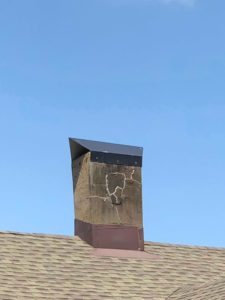An Inefficient Chimney
Chimneys become coated in soot and creosote when not cleaned regularly through routine chimney sweeps. A byproduct of a fire made up mostly of tar, creosote on the walls eventually leads to a buildup that slows airflow in the chimney. As the air slows, it cools faster, stalling in the flue, causing more and more creosote to settle onto the walls. Alone, creosote is not a hazard but over time, it builds up. When a fire is lit in the fireplace, the creosote is warmed to high temperatures that actually makes it boil. As it boils, moisture evaporates, leaving behind a hardened, concentrated tar fuel known as glazed creosote.
Glazed Creosote
Glazed creosote is highly flammable, and extremely hard, which further interrupts the flow of air in the flue. When creosote comes into contact with a hot spark, it can ignite and will result in a catastrophic fire. Imagine dropping a match into a cup of gasoline. The fire is fierce and quick, and the release of this energy in a small space like a flue can be a big problem. For this reason, you should prevent and avoid a creosote buildup in your chimney. Once creosote has reached glazed buildup, chimney professionals have to use a chemical agent to transform it before it is removeable. Scraping this hardened material out of the chimney can damage your flue.
Routine Maintenance Prevents Creosote Buildup
An efficient chimney will produce less creosote. Keep your chimney system safe and efficient by following industry recommendations. The Chimney Safety Institute of America (CSIA) and the National Fire Protection Association (NFPA) both recommend routine chimney sweeps and annual inspections. New Buck Chimney Services offers chimney sweeps and inspections year-round.
Burning Proper Wood Prevents Creosote Buildup
Your chimney will be most efficient if you burn the proper fuel. Properly seasoned wood is the only thing that should burn in your fireplace, stove, or insert. Green wood, trash, clothes, or any other material will burn incompletely, lowering efficiency, but also creating more creosote to coat the flue walls. If you aren’t able to cut and store your own seasoned firewood, you can buy from a local source that sells it.
Using Your Fire Correctly Prevents Creosote Buildup
Despite the temptation of waking up to hot coals, it is not recommended to leave a fire smoldering overnight. Closing the damper on a fire and cutting off oxygen to let it smolder essentially burns the fuel incompletely on purpose. Routinely using this method is promoting creosote buildup in your chimney system.
Avoid a devestating creosote fire by using it properly, burning the right fuel, and hiring professionals for routine maintenance. Call New Buck to ask about our chimney services, and how we are dedicated to keeping homeowners in Shreveport safe.

